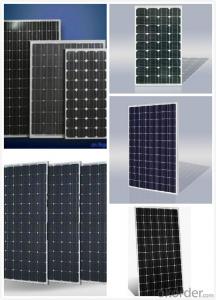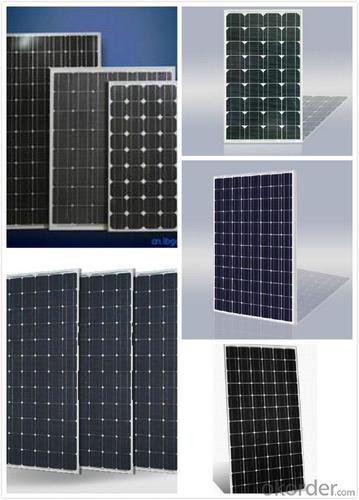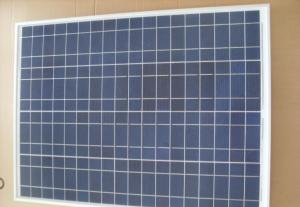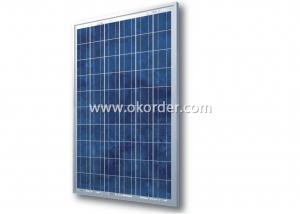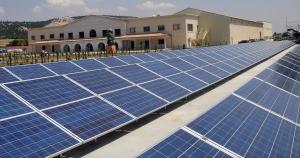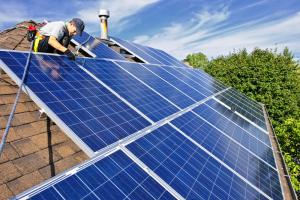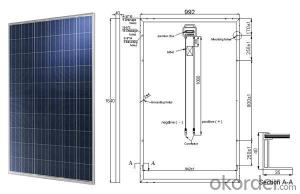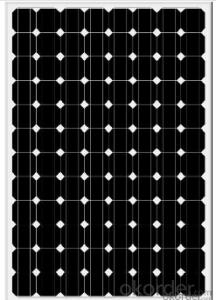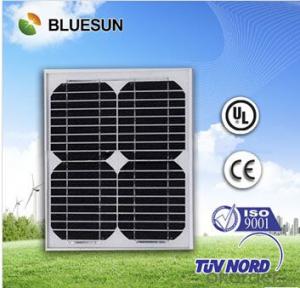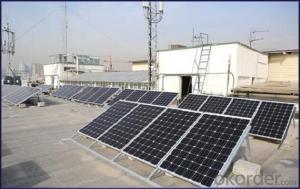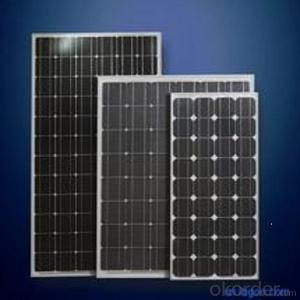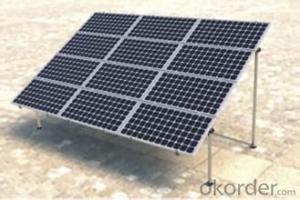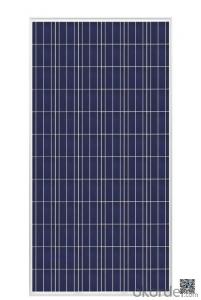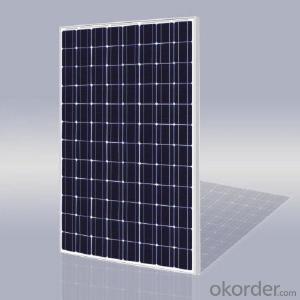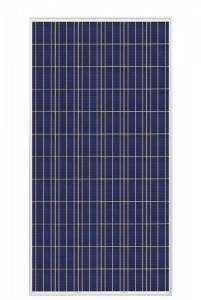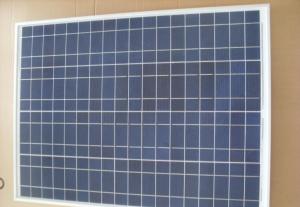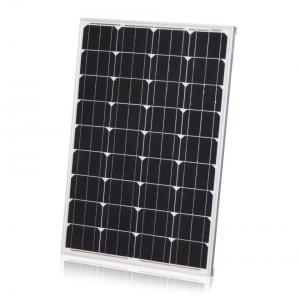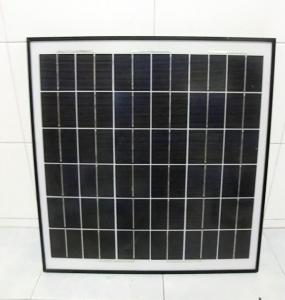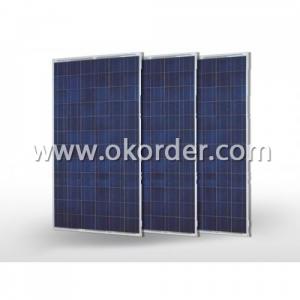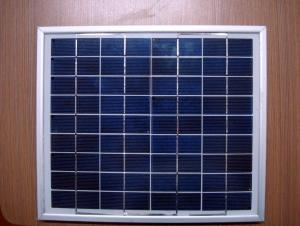Solar Panels on Amazon:High Efficiency Solar Panels, Quality Solar Module Panels
- Loading Port:
- Shanghai
- Payment Terms:
- TT OR LC
- Min Order Qty:
- 2650 watt
- Supply Capability:
- 26000 watt/month
OKorder Service Pledge
OKorder Financial Service
You Might Also Like
Specification
Product Description:
1.Structure of Solar Module Description
Solar panel refers either to a solar hot water panel, a common type of a solar thermal collector, or to one or more solar photovoltaics (PV) modules, electrically connected and mounted on a supporting structure.
A PV module is a packaged, connected assembly of typically 6×10 solar cells. Solar PV panels constitute the solar array of a photovoltaic systemthat generates and supplies solar electricity in commercial and residential applications. Each module is rated by its DC output power under standard test conditions, and typically ranges from 100 to 320 watts. The efficiency of a module determines the area of a module given the same rated output – an 8% efficient 230 watt module will have twice the area of a 16% efficient 230 watt module. There are a few solar panels available that are exceeding 19% efficiency. A single solar module can produce only a limited amount of power; most installations contain multiple modules. A photovoltaic system typically includes a panel or an array of solar modules, an inverter, and sometimes a battery and/or solar tracker and interconnection wiring.
2.Main Features of the Solar Module
1).High conversion efficiencies resulting in superior power output performance.
2).Outstanding power output even in low light or high temperature conditions
3).Optimized design for ease of soldering and lamination
4).Long-term stability,reliability and performance
Specification of Solar Polycrystalline(270W-290W)
CNBM Solar photovoltaic (PV)module is designed for large electrical power requirements. It is the optimal choice for both on-grid and off-grid power systems. CNBM Solar panel offers high performance of power per square foot of solar array.Poly- or multicrystalline silicon(poly-Si or mc-Si): made from cast square ingots — large blocks of molten silicon carefully cooled and solidified. Poly-Si cells are less expensive to produce than single crystal silicon cells, but are less efficient. US DOE data shows that there were a higher number of multicrystalline sales than monocrystalline silicon sales.
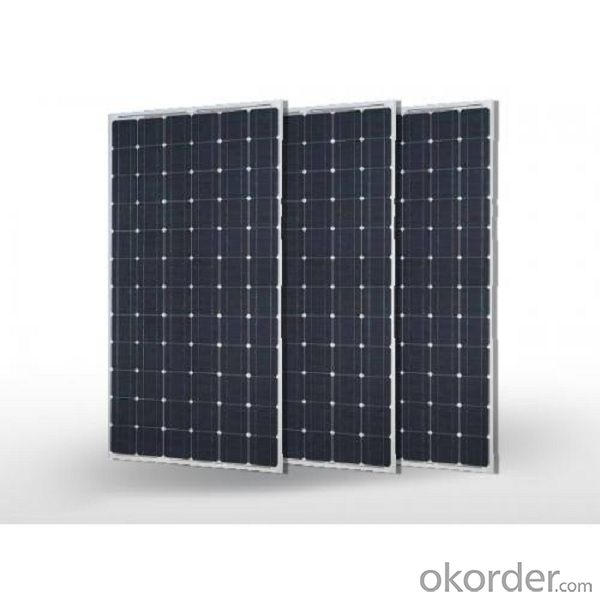
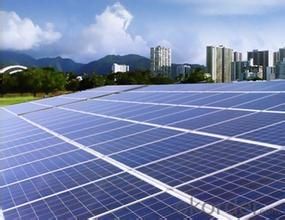
3.Characteristics of Polycrystalline Silicon Solar Panel
I.Solar Cell : High efficiency crystalline solar cell. Even if under the weak light, the solar module can produce maximum power output.
II.Tempered glass (toughened glass): Anti-reflecting coating and high transmission rate glass increase the power output and mechanical strength of solar module.
III.EVA and TPT: Using high quality EVA and TPT to prevent destroying and water.
IV.AI frame: Without screw, corner connection. 6 holes on the frame can be installed easily.
V.Junction box: Multi function junction box with water proof.
VI.Long lifetime: ≥25 years; Less power decrease.
VII.Good performance of preventing from atrocious weather such as wind and hails.
VIII.Resisting moisture and etching effectively, not effected by geology.
IX.The certificate issued by international authority: UL, TUV, IEC, VDE, CE.
- Q: What is the difference b/w them which one is better .
- these solar panels are named different based on the solar cells used... mono-crystalline solar cells: As the name suggests, each cell is made from a slice of a silicon crystal, which is made by purifying, melting and freezing silicon. pol-crystalline solar cells: these are a slight variation of single crystal solar cells. they are made of slices cut out of blocks of several silicon crystals, as opposed to single silicon crystals. check the link below to see other differences between the two types (easy to understand), such as their prices and efficiency levels. there is also a third type of solar cell/panel called amorphous solar cells.
- Q: I had an idea for new parabolic solar panels shaped like horseshoes. They can install them outside buildings facing the equator. They could angle them from the ground based on how many degrees latitude the location and rotate them according to seasonal changes. The disadvantage of photovoltaic panels is that they are not all capable of receiving direct sunlight. That is the quintessential reason I believe horseshoe solar panels are more effective than flat rectangular ones. One side could function in the morning; the middle could perform at midday; and the other could operate during the evening. That method seems more sensible than hourly positioning. I'm certain horseshoe panels could save and produce more electricity. A football stadium, shopping mall, or outlet center would be a fantastic place. What do you think?
- Well here would be the problem with a horseshoe panel... Due to its shape, you will get a seriously uneven distribution of solar charge. Since the horseshoe shape resembles a parabolic function, the majority of the electrical photovoltaic cells will be spanned over the larger rise/run, meaning the two ends of the parabolic shoe. A way to combat this is that as it approaches 0 from both sides (0 tangency) is to put a higher concentration of photovoltaic cells in comparison to the two ends on either side. An even better design I would say would not to use a flat panel or even a horseshoe, but instead, use a sphere shape. It's globe-like shape would never need to be adjusted. The side pointing towards the sun would absorb and the remaining 360 degrees of shape would absorb ambient light which can trickle in tons of ambient charge. It is an eyesore but the round shape would be the most efficient. If you think about it, nature is the best example to model. Just look at a tree. It's general tree shape is rounded so that all the leaves can pick up some sort of light throughout the day.
- Q: I'm trying to charge rechargeable AA batteries with a solar panel. What guage wire should I use to connect the panel to the batteries? Should I use a diode to keep the batteries from overpowering the circuit? If so, what size? My panel is 4.8V 50mA.
- How photograph voltaic Cells artwork via Scott Aldous interior this text a million. advent to How photograph voltaic Cells artwork 2. Photovoltaic Cells: changing Photons to Electrons 3. How Silicon Makes a photo voltaic cellular 4. Anatomy of a photo voltaic cellular 5. power Loss in a photo voltaic cellular 6. photograph voltaic-powering a house 7. fixing photograph voltaic-power subjects 8. photograph voltaic-power experts and Cons 9. so a lot greater coaching 0. See all actual technological understanding articles you have probably seen calculators that have photograph voltaic cells -- calculators that for the period of no way decide for batteries, and specially circumstances do no longer even have an off button. as long as you have sufficient easy, they seem to artwork invariably. you need to have seen larger photograph voltaic panels -- on emergency highway signs and warning signs or call bins, on buoys, even in parking a lot to power lighting fixtures furniture. in spite of the undeniable fact that those larger panels are not as common as photograph voltaic powered calculators, they're accessible, and not that troublesome to locate in case you comprehend the place to look. There are photograph voltaic cellular arrays on satellites, the place they're used to power the electrical powered structures. you have probably additionally been listening to with reference to the photograph voltaic revolution for the final 2 many years -- the theory sooner or later we can all use loose electrical energy from the sunlight. this could nicely be a seductive promise: On a marvelous, sunny day, the sunlight shines approximately a million,000 watts of power in line with sq. meter of the planet's floor, and if we ought to deliver jointly all of that power we ought to actual power our homes and places of work for loose.
- Q: Composition and function of solar panels
- Among them, for the electronic grade polysilicon accounted for about 55%, solar grade polysilicon accounted for 45%, with the rapid development of photovoltaic industry, solar cell demand for polysilicon growth rate higher than the development of semiconductor polysilicon, is expected to 2008 solar polysilicon
- Q: What specification of solar panel would I need to power a laptop every day? I would need to use it for about 0 hours or so every day. I don't know anything about solar panels, but I am seriously thinking of getting one now and don't know who to ask.
- You will need, A battery to store the electricity from the solar panel. The amount of electricity from the panel varies up and down as things such as clouds, position of the sun, etc. reduce the amount of solar rays hitting the panel. The battery stores it all, the ups and downs, and sends it back out at a steady voltage so you can operate your p.c. / appliance. A minimum of 45 watts solar panel. 60 watts would be preferable. 45 watts will charge a battery in one day under ideal conditions. You turn the panel as the sun moves across the sky, no clouds. 60 watts will charge a battery in one day with out moving and regardless of clouds. A controler to prevent the electricity from flowing backwards from the battery to the solar panel when the sun goes behind a cloud or sets at night and the charge drops below the voltage of the battery. A good controller will tell you the charge condition of your battery so you know when it is too low to operate your p.c. safely. And finally an inverter with True Sine Wave capability to change the electricity from the battery into usuable power for your PC and other electronics. Not all inverters produce true sine wave electricity. The electricity has static in it and will make your pc screen jump around and not function as it should. New digital T.V.'s also require true sine wave electricity to operate. Go the extra cost and get the inverter with true sine wave and be happy with the way your p.c. functions. Figure out how many Watts your p.c. or appliance will draw. and match the Inverter to the need. Do not go too big, as they cost more and consume more of your stored electricity to operate. Save as much electricity as you can. You will be able to operate your p.c. appliance longer. When not using your p.c., you can operate your T.V. or other low watt appliance.
- Q: I'm doing a science fair experiment with a tiny two-inch solar panel that only gives off like .5 volts of energy, but I need to know how many volts an average sized solar panel (like one you'd get to run your house) would produce. And how many panels do people usually get?
- You should read up on the different electrical units. You say .5 volts of energy, but this makes little sense. Energy is measured in Joules. Power in Watts. Solar panels will produce different voltages and currents, depending on the amount and angle of sunlight hitting them. Power = volts * amps. Before installing solar panels a home owner should do an energy audit to find out how much power they currently use - and how much that could be reduced with some easy changes. Solar panels are expensive, so it makes sense to reduce the amount that you need to install. In some places you can sell extra power back to your utility - so having extra panels might give you some small amount of money back - but this is rarely enough to justify the cost of the extra panels. I put 28 panels on my house (see picture in source URL). My utility has tiered pricing for electricity (first few kWh each month are cheap, but price for extra ones goes up in stages). My panels keep me from having to pay the higher rates.
- Q: Would it be possible to use a lens or a mirror to focus light onto a solar panel in order to make in more efficient? And is something like this already being used? It was just a thought and I haven't spent much time on it, but I figured I'd ask.
- yes it is being done. i've seen adds for such a system. on the other hand, if you had a 5 sq in Lens focused on a small cell, and a 5 sq in cell, they'd be about the same. in fact, the cell might be a bit better because (A) there wouldn't be any loss in the Lens, and (B) it might be that the solar cell would use some frequencies to which the Lens was opaque. in addition, the cost of solar cells is dropping, making the cost of the mirrors or lenses uneconomical by comparison.
- Q: Can solar panels be installed on streetlights?
- Yes, solar panels can be installed on streetlights. They provide a sustainable and cost-effective solution by harnessing the sun's energy to power streetlights, reducing the dependence on traditional electricity sources and lowering overall energy costs. Additionally, this renewable energy option helps to reduce carbon emissions and promote environmental sustainability.
- Q: Are there any government incentives for installing solar panels?
- Yes, there are various government incentives available for installing solar panels. These incentives can include tax credits, grants, and rebates provided by federal, state, and local governments. These programs aim to promote the adoption of renewable energy sources and help reduce energy costs for homeowners and businesses.
Send your message to us
Solar Panels on Amazon:High Efficiency Solar Panels, Quality Solar Module Panels
- Loading Port:
- Shanghai
- Payment Terms:
- TT OR LC
- Min Order Qty:
- 2650 watt
- Supply Capability:
- 26000 watt/month
OKorder Service Pledge
OKorder Financial Service
Similar products
Hot products
Hot Searches
Related keywords
